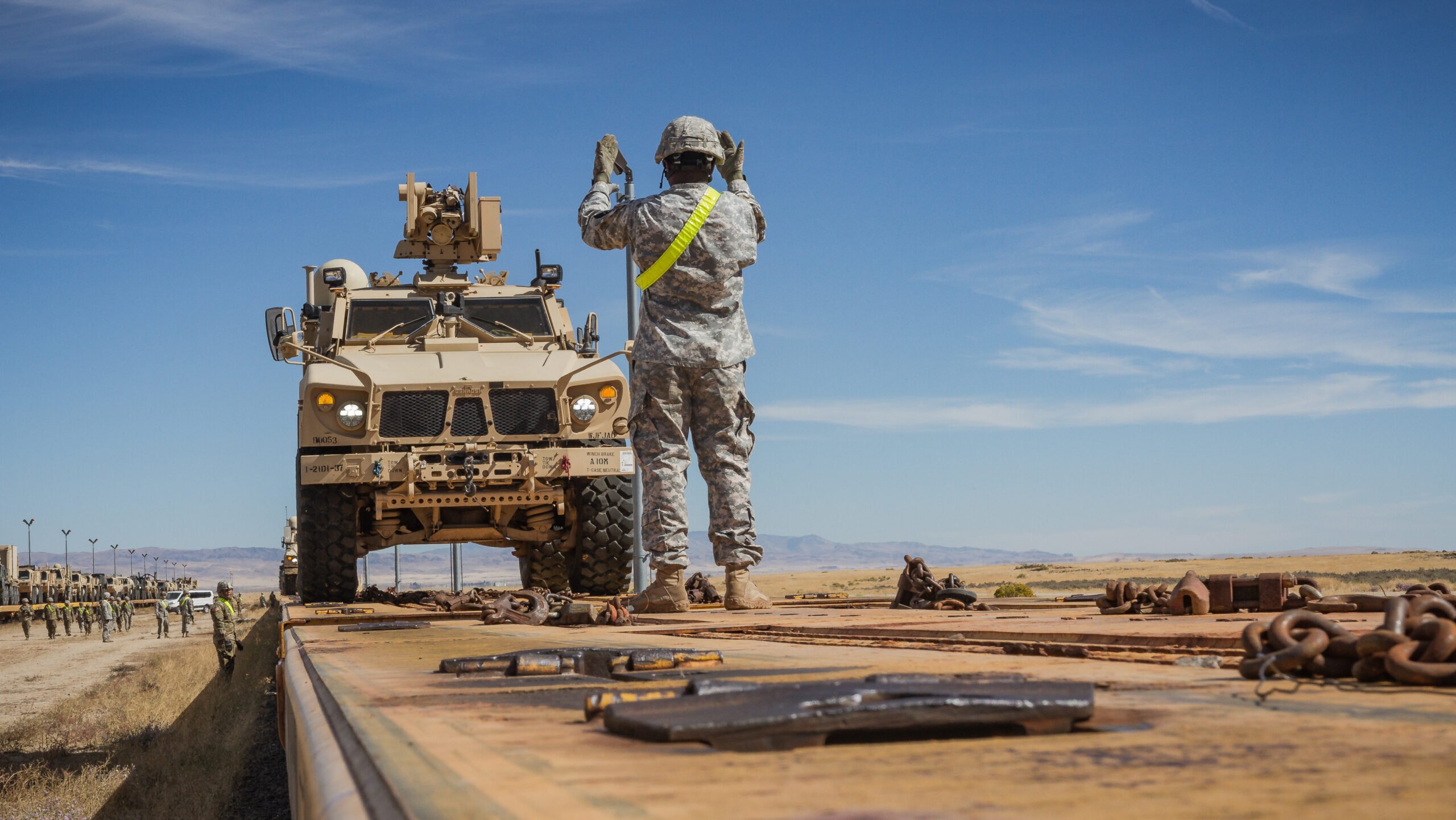
A U.S. Army Soldier assigned to 1st Battalion, 37th Field Artillery Regiment, 2nd Infantry Division Artillery guides a mine-resistant, ambush-protected vehicle during rail offload at Orchard Combat Training Center, Idaho, Sept. 25, 2016. (Capt. Brian Harris, 16th Combat Aviation Brigade)
The Pentagon has long worried over its ability to move at the speed of conflict, as entrenched acquisition processes can delay getting the right weapons to the right warfighters. In this op-ed, acquisition expert Jerry McGinn lays out how the Defense Department can improve, using one success story as a template.
COVID-19, US military support to Ukraine and Israel, and potential contingencies in East Asia have demonstrated profound challenges in our industrial base. To address these shortcomings, the Department of Defense (DoD) is preparing to release its inaugural National Defense Industrial Strategy.
Under Secretary of Defense Bill LaPlante outlined the strategy’s four major themes at the Reagan National Defense Forum – resilient supply chains, workforce readiness, flexible acquisition, and economic deterrence. The draft strategy shared with Congress and reported by some media outlets is a strong call to action, but the key of course will be how this strategy is implemented. Resources are part of the solution, but the success or failure of this effort principally hinges one of LaPlante’s themes: flexible acquisition, specifically DoD buying and contracting practices.
DoD must put our industrial base on a wartime footing or potentially face catastrophic consequences. Here’s how DoD can do that, using former Secretary of Defense Bob Gates’ experience with the Mine Resistant Ambush Protected (MRAP) vehicle as a guide.
In short, we need to fundamentally change how we buy to accelerate the production of systems to equip and sustain our warfighters. As noted in the draft strategy, DoD needs to “orient acquisition policy for aggressive expansion of production capacity.” And that comes down to how we design, budget, solicit, and contract for those systems. Let’s take each in turn after a brief discussion of what I call the MRAP mindset.
Calls for the return of World War II’s arsenal of democracy are inspiring, but the much more recent MRAP experience is a better model for today. Secretary Gates became furious in the mid-2000s when US forces in Iraq and Afghanistan were being killed by improvised explosive devices at an alarming rate, and he felt that the Pentagon bureaucracy was not working fast enough to protect deployed warfighters.
He famously remarked that “the troops are at war, but the Pentagon is not.” He then personally led the effort to procure and field the MRAP to increase soldier survivability. The dramatic acceleration of the development, procurement, and fielding of almost 14,000 of these life-saving MRAPs within three years from the government’s request for proposals was the result. Gates’ outsized role in this effort and the resources at his disposal were certainly significant, but it was the sense of urgency and the way he made the system work much faster that exemplifies the mindset needed today.
The military services, working with industry, design and develop the most exquisite systems for our warfighters. They are designed, however, for limited quantity production runs meeting rigorous military specifications. This has been on full display in the industrial base response to support Ukraine. While some progress has been made increasing the production of munitions, challenges continue to stymie defense production despite significant leadership attention and resources.
We need to flip the script and design classes of munitions and systems for producibility.
The Air Force Program Executive Office for Weapons is pursuing just such an approach with its Enterprise Test Vehicle risk reduction effort that is being competed via the Defense Innovation Unit’s commercial solutions opening. The objective of this effort is to “demonstrate an aerial platform that prioritizes affordability and distributed mass production.” We need to focus on fostering this production-oriented approach to design, using digital engineering, modular open systems approach (MOSA) and similar methods.
Similarly, Deputy Secretary of Defense Kath Hicks’ Replicator initiative is focused on buying commercially produced systems that can meet some or most of the capabilities of advanced military systems. Hicks rightly used the above Gates quote at the Replicator launch to place the focus on fielding “attritable autonomous systems at a scale of multiple thousands, in multiple domains, within the next 18-to-24 months.”
The focus on speed and the use of mature technology mirrors the approach to MRAPs, which had an extremely limited set of requirements and used largely existing designs. There is growing frustration that Replicator is taking time to come into focus, but Hicks’ single-mindedness on “improving our ability to scale” is exactly right.
DoD budgets for systems through the Cold War-era Planning, Programming, Budgeting, and Execution (PPBE) system that essentially requires over two years of advanced planning before funds start to flow. The limitations of PPBE are well known and the Congressional PPBE Reform Commission’s Interim Report highlighted some potential recommendations under consideration to promote innovation and adaptability. The Commission, which our center is currently supporting, is examining ways to enable the insertion of emerging technologies to meet immediate operational needs.
Acting essentially as the MRAP’s program manager, Gates was able to overcome all manner of budget obstacles to help enable that program’s success. That obviously is not a workable long-term solution, so PPBE reform and efforts such as the $1 billion “hedge portfolio” in the fiscal year 2024 House appropriations bill to accelerate the production of emerging technologies over a one-to-three year period are critical to help speed production and get systems to warfighters faster.
Changing how the department buys capabilities is another way to increase the scalability of production. Efforts to increase munitions production have appropriately put the focus on the importance of a clear demand signal from government to industry. Contract opportunities are ultimately what incentivize companies to invest, so let’s focus on increasing contract opportunities through multiple awards, second sourcing, and recurring competition where feasible.
Initiatives such as multi-year procurement are essential and multiple lines of production were central to MRAP’s success at scaling. The Army’s recent set of contract awards to nine companies based in the United States and allied countries for 155mm ammunition production is one example of employing that approach, but DoD needs to take this mindset well beyond munitions. Changing incentive structures rather than sustaining decades-long franchise programs will reduce costs over time and increase capacity across the industrial base.
The final key to creating scalability in our industrial base is contracting. Contracts are the literal manifestation of how industry and government work together. Companies perform to meet the precise terms of the contract, so another way to rapidly increase production capacity would be to add a surge line — CLIN in DoD parlance— to the contract.
DoD could include surge CLINs, for example, that direct the company to conduct the design and planning work to be able to ramp up production by 50 percent in six months should DoD decide to issue a contract modification to do so. DoD will pay a bit more upfront for this capacity, but it will certainly reduce the time necessary to ramp production in a time of crisis.
Adopting a MRAP mindset is essential to getting our industrial base on the wartime footing required for today’s challenges. As LaPlante has said repeatedly, “production is what matters and everything else follows from that.” From design and budgeting through solicitation and contracting, changing how the department buys will enable us to produce more to better equip and sustain our forces as well as our allies and partners. DoD, Congress, and industry need to go all in to make this happen. There is no time to waste.
Jerry McGinn, Ph.D., is the Executive Director of the Greg and Camille Baroni Center for Government Contracting in George Mason University’s Costello College of Business and former Acting Deputy Assistant Secretary of Defense for Manufacturing and Industrial Base Policy.





















